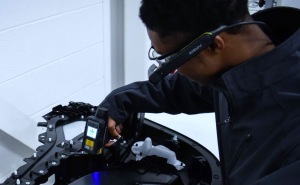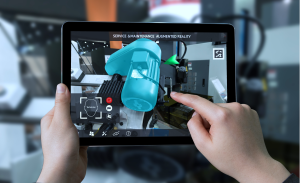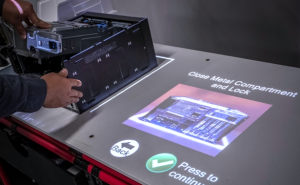
Led by Industry 4.0, manufacturers now have many smart technologies at their disposal that help companies solve operational challenges and adapt quickly to product and production changes. Among these emerging technologies is augmented reality (AR), which, according to PR Newswire, will become a $70 billion industry by 2025.
The industrial AR industry is growing because the technology is becoming a critical part of the modern manufacturing tech stack—a stack of technologies that connect machines, processes, and people for improved quality, higher throughput, and fewer errors. For example:
IIoT, coupled with big data and analytics, is surfacing more insight into operations, providing more visibility into processes and control over results.
Digitalization is replacing paper on the shop floor, putting critical information at the fingertips of the right people at the right time, as opposed to paper documentation, which is never available when needed and always seems to be out of date if you do find it.
ERP systems now integrate with automation and control systems, enabling manufacturers to lower costs, improve decision making, and better serve customers.
While many manufacturers use automation solutions, there is an opportunity to achieve the same level of standardization for manual processes. According to Kearney survey respondents, 72% of the tasks in a factory are still performed by humans.
Manual processes are still a big part of manufacturing. Augmented reality (AR) for manufacturing has been getting traction as a new tool to streamline manual processes, train workers more quickly, ensure quality, and ramp up throughput.
AR uses technology to augment the user’s real-world environment with digital content as they work. By delivering work instructions visually in a way that enables employees to “interact” with them, manufacturers are improving the quality of manual assemblies. Successful AR on the factory floor is dependent on matching the right type of AR to solve specific manufacturing problems.
While AR isn’t new, recent advancements in the technology are making AR a practical solution for many manufacturing challenges. As a result, AR has not only become part of the next generation of Industry 4.0, but it is changing manufacturing entirely. With this in mind, it’s clear that strategic implementation of AR technology is absolutely necessary to the future of industry.
Currently, there are three basic types of augmented reality for manufacturing:
- Wearable
- Tablet-based
- Projected
In this article, we’ll cover the pros and cons of each type of industrial AR and how each is currently being used to support manufacturing.
Wearable AR![Operator wearing wearable augmented reality smart glasses]()

What Is Wearable AR?
Wearable AR displays graphics onto the worker’s environment through smart glasses or a headset, which are lightweight, hands-free devices that display and store information. Popular wearable AR solutions available today include Google Glass and Microsoft HoloLens.
Common Uses for Wearable AR in Manufacturing
Smart glasses like these shine in field service, mobile warehousing, and maintenance, where workers can use AR in shorter bursts to help ensure fast, high-quality results. Two strengths of AR smart glasses for manufacturing are mobility and hands-free access, with additional benefits for immersive, interactive training.
For example, some augmented reality glasses enable operators to take photos and videos, including a “see what I see” capability that facilitates live remote assistance. For example, if a technician is working on an unfamiliar maintenance process, they can connect with an expert who can see what the technician is doing and walk them through the process.
Benefits of Wearable AR
Wearable AR is popular due to its mobility, dynamic graphics, and the public’s general familiarity with the technology—most people associate “AR” with wearable smart glasses. As an ergonomic, untethered self-contained holographic device, smart glasses or headsets display work instructions in the worker’s field of view as they work, putting the right information in the right place.
This functionality dissuades the need for workers to constantly look away from their work to reference paper-based or tablet-based instructions, allowing them to work faster and with fewer mistakes. Because of this, many manufacturers have increased productivity with wearable AR solutions.
Tradeoffs & Things to Consider
While smart glasses are highly effective for many applications, manufacturers need to consider the logistics of how the technology will work on the factory floor, day in and day out.
Because wearables use batteries, achieving reliable battery power throughout a shift (or across shifts) can be difficult. Batteries must be charged and ready to go when work starts. Since a charge typically lasts 3-4 hours, freshly charged devices or hot-swappable batteries must be ready to go when battery life wanes. Keeping batteries and devices fresh add time and steps to the manufacturing process. Someone has to manage the process of charging batteries, assess battery performance and health, and get them into workers’ hands, which can counteract the efficiencies gained in production.
Wearables also require a Wi-Fi connection, which can pose security issues if proprietary or confidential information is being transmitted. Hackers can also use unsecured endpoints like wearable technology to gain access to the company network. In addition, Wi-Fi can introduce latency. If the connection becomes too slow, it may not keep up with production.
In some instances, wearables can pose a safety risk because AR smart glasses and headsets can obstruct the operator’s field of view. Some glasses and headsets are not designed for prolonged use, so operators may experience dizziness, nausea, or eyestrain.
RELATED ARTICLE: Learn More About AR Smart Glasses
Tablet-Based AR![Worker using tablet-based augmented reality]()

What Is Tablet AR?
Tablet-based augmented reality uses tablets and other handheld devices, such as smartphones, to deliver work instructions through AR apps. This type of AR was originally popularized on social media through apps like Snapchat. Over the past few years, tablet-based AR has made its way to the factory floor.
Common Uses for Tablet AR in Manufacturing
Tablets can be an affordable way to bring AR into manufacturing processes and are easily adopted due to people’s familiarity with tablets and how to use them. In general, tablet-based AR works for processes that need general guidance and short bursts of information. If your application involves a simple set of work instructions in a low-variation environment, tablet-based AR can be a good solution. It can deliver the right information, but not necessarily at the right place or time. For example, Tablet-based AR is effective for referencing a service manual during a maintenance procedure.
Benefits of Tablet AR
The biggest benefit of tablet-based AR is its simplicity. Setup time and training are generally shorter because of users’ general familiarity with tablets and smartphones. Setup can be as simple as downloading an AR app, so you get up and running quickly.
Because tablets are everywhere, they’re easy to buy and you can get them quickly. Accessories like chargers and third-party services for repair and maintenance are also easily available. AR tablets are good for bringing new employees up to speed quickly with hands-on field training, working remotely with experts to solve problems faster, minimizing downtime, and reducing costs.
Trade-offs & Things to Consider
While tablet-based AR is inexpensive and quick to implement, there are trade-offs with limitations in screen size, scalability, and worker engagement.
The hand-held nature of phones and tablets are a big drawback for any factory process that requires both hands. Imagine trying to assemble a four-foot-long wire harness one-handed!
Tablets and smartphones also require charging, which can take hours. Even if your devices run on hot- swappable batteries, someone has to ensure that the battery pool is charged and ready to go. Time invested in waiting for batteries to be charged can negate gains in productivity.
Phones and tablets also require Wi-Fi connectivity, which can pose security risks. By adding more endpoints to your network, you’re also adding vulnerabilities that must be secured. And if security isn’t an issue for your company, latency might be. Slow connection speeds and data bottlenecks can slow down operations rather than increase productivity.
In addition, staring at a screen for long periods can negatively affect your eyesight. The average person picks up their smartphone up to 150 times per day. Adding a full workday of focusing on a screen will amplify the problem.
Perhaps the biggest concern about phones and tablets on the factory floor is that referencing a tablet for work instructions draws attention away from the operator’s work surface. By constantly splitting attention between a device and the work, operators won’t gain much, if any, efficiency, and can potentially lead to quality issues.
RELATED: Learn More About Tablet AR
Projected AR![Operator using projected augmented reality to assembly PC]()

What Is Projected AR?
Projected AR combines AR projectors and vision sensors to display precise step-by-step work instructions as interactive graphics onto any work surface using a series of audio and visual prompts. Because graphics, animations, videos, and text appear directly on the fixture or part being assembled, projection-based augmented reality is the only type of AR that provides instantaneous, full-time operational guidance for assembly, part picking and kitting, testing and inspection, training, and maintenance.
Although relatively new, projected AR has proven to be a valuable addition to factory floors across nearly every industry. As an industry-leading supplier of AR technology, LightGuide works with a variety of leading automotive, aerospace, electronics, food and beverage, diverse manufacturing, and healthcare companies to solve a growing variety of challenges.
Common Uses of Projected AR in Manufacturing
A key feature of projected AR is its flexibility, which makes it adaptable to a variety of manufacturing applications.
Work Instruction Standardization
For many industries, consistent precision is essential for optimal quality, especially for processes with high variation. But with different people working different shifts and in different locations, process standardization across the enterprise can be a challenge.
Projection-based AR enables manufacturers to write and deliver standardized work instructions that are intuitive, interactive, and easy to follow. This gives manufacturers confidence that each assembly is built the same way across shifts and locations. Consistent, standardized work instructions lead to improved quality, particularly if AR software is programmed to support a “no-faults forward” approach to manufacturing.
Part Picking and Kitting
If you’re kitting parts and components to a build line, you know that errors such as incomplete kits or kits with wrong parts have consequences. Because errors in kitting can slow down production, precision and quality in kitting is essential for high productivity and throughput.
Projected AR solutions from LightGuide include SpotGuide, which quickly guides workers through the process of finding and picking the correct parts in the correct order, minimizing or eliminating errors in kitting.
Assembly
AR projectors guide operators through each step of an assembly process, providing confirmation of success in each step of a process, or flagging errors that need to be corrected before moving on to the next step. This ensures that assemblies meet quality standards as they are made. This builds quality into the manufacturing process and leads to higher yields and decreased assembly times.
Training
Standardized training with projection-based AR helps speed up the process to quickly fill knowledge and skills gaps. Manufacturers using AR for training can get new employees, contractors, and substitutes up to speed quickly. Projection-based AR can deliver intuitive training with testing to validate understanding. And because projection-based AR trains employees on best practices from day one, manufacturers can get higher first-time quality.
RELATED ARTICLE: 6 Uses of Augmented Reality for Every Industry
Benefits of Projected AR
Projection-based AR visualizes each step of a process for an operator. With the right information delivered at the right place and right time, operators can keep their attention—and both hands—on their work and focus on the quality of each action. This minimizes errors to improve quality, and many manufacturers have reported gains in throughput as well.
Because projection-based AR delivers work instructions one step at a time, operators are prevented from moving to the next step until the AR system confirms that the current step is successfully completed. This enables a “no-faults forward” approach to manual processes, which can improve quality and minimize delays.
AR projectors also gives operators more freedom than wearables and tablets. And with no distracting headset, glasses, or handheld device, operators are much less likely to cross paths with a safety hazard. In addition, projection-based AR systems don’t rely on batteries or WiFi connectivity, keeping them untethered and aware of their surroundings.
Projection-based AR is designed specifically for industrial applications. The hardware components are rugged enough to run in 24/7 manufacturing operations and can operate in harsh environments, making it ideal for the most challenging applications. They are also flexible enough to integrate with new or existing production cells and can be easily moved around the factory. You can even integrate projection-based AR systems with MES and other common manufacturing technology.
Tradeoffs & Things to Consider
The primary concern about projection-based AR is that it’s new and not well known. This leads manufacturers to wonder if it’s actually reliable and if it will have a real impact on quality and operational efficiency.
While the technology is new, it’s not unproven. Projection-based AR is already in use in thousands of applications worldwide and has proven to deliver the highest value for manufacturing operations when compared to wearables and tablets.
Because projection-based AR systems operate in a fixed location and secured on the workstation, system mobility is limited. It takes time to repurpose a projection-based AR station to another location. While this can be perceived as a drawback, the advantage is that operators aren’t at risk of moving around, being distracted, and possibly putting themselves in harm’s way.
RELATED: Why Use Projected AR?
Deciding Which Type of Augmented Reality Is Right for Your Factory
When deciding which type of AR is right for your manufacturing needs, it’s best to consider which use cases will benefit most from AR and which type of AR best supports those use cases.
For general short-term guidance, tablet AR is fast, efficient, and affordable. The public’s familiarity with tablets results in quick adoption giving you fast time to value. But it’s important to consider whether a hand-held option will hinder operators’ ability to work efficiently.
If your operations require mobility and hands-free operation, wearables are an ideal solution. You can move work instructions quickly to different locations around the factory while giving workers the freedom to work with both hands. Manufacturers should consider whether network connectivity is robust enough to allow for continuous operations or whether battery charging will be cumbersome or disruptive. In addition, safety concerns should be carefully considered.
If you’re in a high-variation production environment, projected AR is ideal because the solution easily adapts to low-volume and high-volume operations across most industries and applications. Because projected AR displays work instructions directly onto an operator’s work surface, complex variations become simple and intuitive, giving workers an edge in productivity and quality. Power, connectivity, and data security are built into the solution so busy operations professionals spend less time managing these potential complexities.
Before implementing any new technology into your factory, carefully consider your manufacturing needs and production environment to ensure your AR solution will deliver the benefits you need.
Interested in learning more about AR for manufacturing? Contact us to schedule a consultation with one of our AR experts.

